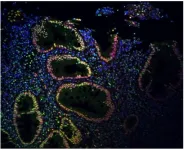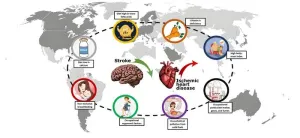(Press-News.org) Individual motivation to act against climate change outweighs the impact of hyperlocal collective intentions, though both approaches are worth strengthening, according to a survey of nine European neighborhoods published Nov. 20, 2024 in the open-access journal PLOS Climate by Christian A. Klöckner from the Norwegian University of Science and Technology and colleagues.
Western society contests the individual versus collective responsibility to combat climate change. But do people feel more motivated to act individually (e.g., making waste-free purchasing choices) or in tandem with others (e.g., protesting or completing workplace waste reduction challenges)? Klöckner and his colleagues investigated why citizens take pro-climate action in a hyperlocal, understudied environment: the neighborhood.
They surveyed 1,084 residents of nine European neighborhoods during the summers of 2022 and 2023: three neighborhoods in Austria and two each in Italy, Norway and Finland. Respondents described their neighborhoods’ cultural and social environments and what motivates their individual and collective pro-climate actions. Participants self-reported these climate-conscious habits across four categories: diet (e.g., eating vegan), travel (e.g., carsharing), protest (e.g., signing a petition) and general behaviors (e.g., buying items secondhand).
Results indicated that individual, collective, cultural and socio-structural factors were all to some degree associated with respondents’ self-reported responses to climate change. Socially, men reported weaker individual intentions to act and weaker pro-climate attitudes (but not weaker climate action) than women. Larger households generally reported more pro-climate behaviors, and those with children younger than 14 years old reported less. People with university degrees reported more pro-climate behaviors and a stronger intent to act individually. Full-time workers reported a weaker intent to act collectively.
Both individual and collective intentions to fight climate change were associated with increased climate action behaviors. Generally, perceived individual efficacy motivated participants’ intention to act individually, while the relationships among neighbors — also known as a neighborhood’s social capital — motivated collective intent to act. The researchers suggest physically reconfiguring neighborhoods to strengthen local networks and galvanize collective action.
Because this study’s participants are highly localized, the researchers caution against generalizing their results and encourage investigating additional European and non-European neighborhoods.
The authors summarize: "Climate mitigation is a collective task; therefore we analysed the role of neighbourhoods in motivating climate action. We found that in neighbourhoods with high social capital, climate action is easier to engage in."
#####
In your coverage please use this URL to provide access to the freely available article in PLOS Climate: https://journals.plos.org/climate/article?id=10.1371/journal.pclm.0000424
Citation: Klöckner CA, Brenner-Fliesser M, Carrus G, De Gregorio E, Erica L, Luketina R, et al. (2024) Climate actions on the neighbourhood level—Individual, collective, cultural, and socio-structural factors. PLOS Clim 3(11): e0000424. https://doi.org/10.1371/journal.pclm.0000424
Author Countries: Austria, Finland, Italy, Norway
Funding: This study has been conducted in the JPI Climate project “CLEAN Cultures”, which is funded in JPI Climate joint transnational call SOLSTICE (Enabling Societal Transformation in the Face of Climate Change). Project numbers: Norwegian Research Council 321315, funding achieved by CAK; Academy of Finland (funding decision number 338128, funding achieved by LSO); Austrian Research Promotion Agency 879545, funding achieved by MBF; funding by the Italian Ministry of Education, University, and Research, funding acquired by GC. The funders had no role in study design, data collection and analysis, decision to publish, or preparation of the manuscript.
END
Won’t you be mine? Neighborly networking may motivate local climate action
Researchers surveyed climate action catalysts, barriers in nine European neighborhoods
2024-11-20
ELSE PRESS RELEASES FROM THIS DATE:
Mental health issues are "prevalent and troubling" among forcibly displaced children and young people, per scoping review which finds PTSD, anxiety and depression to be most common conditions
2024-11-20
Mental health issues are "prevalent and troubling" among forcibly displaced children and young people, per scoping review which finds PTSD, anxiety and depression to be most common conditions.
+++++
Article URL: https://journals.plos.org/mentalhealth/article?id=10.1371/journal.pmen.0000076
Article Title: Mental health issues of children and young people displaced by conflict: A scoping review
Author Countries: Nigeria, United States
Funding: The authors received no specific funding for this work. END ...
How nerve stimulation could ease inflammatory bowel disease
2024-11-20
Researchers at Duke University School of Medicine have found that tapping into the nervous system could help reduce the gut inflammation that drives inflammatory bowel disease (IBD).
A new study led by Luis Ulloa, PhD, and Wei Yang, PhD, reveals how electrical stimulation of the vagus nerve—a major nerve connecting the brain and gut—may combat the stress-related inflammation that worsens IBD symptoms.
Published in Science Translational Medicine, the study showed that vagus nerve stimulation in stressed mice with colitis, a form of IBD, reduced inflammation, improved symptoms, ...
The factors behind the shifting trends of ischemic heart disease and stroke
2024-11-20
Incidence of stroke and ischemic heart disease are declining around the world, except for in a handful of regions, according to research in the open access journal PLOS Global Public Health. Wanghong Xu of Fudan University and colleagues find that in East and West Sub-Saharan Africa, East and Central Asia and Oceania, ischemic heart disease is increasing, which may be attributed to eight factors that include diet, high BMI, household air pollution and more.
Cardiovascular disease is a leading cause of death and disability worldwide, and ischemic heart disease and stroke ...
How educational attainment may impact memory and dementia risk later in life
2024-11-20
Historical policies shaping educational attainment have enduring benefits for later life memory and risk of dementia, according to a study led by a Rutgers Health researcher.
The study, published in Epidemiology, compared the differences in years of education based on variations in state schooling mandates with cognitive performance outcomes in residents decades later.
“Policies to increase the quantity or quality of schooling now are likely to have long-term benefits on cognitive outcomes,” ...
Growing soybeans has a surprisingly significant emissions footprint, but it’s ripe for reduction
2024-11-20
AMES, Iowa – Over the typical two-year rotation of corn and soybeans most Iowa farmers use, 40% of nitrous oxide emissions are in the soybean year, according to a new study by an Iowa State University research team.
The share of the potent greenhouse gas released during the soybean half of a crop rotation cycle is surprisingly high, given most soybeans fields aren’t treated with nitrogen, said Michael Castellano, agronomy professor and William T. Frankenberger Professor of Soil Science at Iowa State University.
“We’ve just been assuming that legume crops like soybeans don’t have a big emissions footprint because they don’t ...
$6 million grant drives potential treatment for common cause of vision loss toward the clinic
2024-11-20
The California Institute for Regenerative Medicine (CIRM), the state’s stem cell agency, has awarded a two-year, $6 million grant to a team at the USC Dr. Allen and Charlotte Ginsburg Institute for Biomedical Therapeutics and the USC Roski Eye Institute advancing a new treatment for one of the leading causes of blindness in older adults. The funding will enable the researchers to conduct preclinical studies needed before launching human trials.
The investigators aim to accelerate progress in fighting dry age-related macular degeneration (AMD), which affects ...
Research aims to roll back contamination caused by toxic tires
2024-11-20
University of Delaware researchers have developed a method for mitigating the decontamination that tires release into the environment at the end of their lifespan.
In a new study published in Nature Chemical Engineering, the team demonstrated a way to upgrade 6PPD – a molecule that provides UV protection to help the rubber found in tires last longer – into safe chemicals. The method would also turn the leftover crumb rubber into aromatics and carbon black, a soot-like material found in everything from pigments to cosmetics to electronics. ...
School social workers an underutilized resource
2024-11-20
Youth in America are experiencing a mental health crisis, according to the Centers for Disease Control and Prevention (CDC). The CDC reports that an increasing number of students are experiencing symptoms of hopelessness, depression, and anxiety, along with thoughts of self-harm.
One thing known to improve mental health among students is increased school connectedness—when students feel that the adults and peers in their school care about them as individuals in addition to their learning ability. Schools are working to improve their connectedness by adding social workers to their staff to help address the mental health concerns of students.
However, ...
Increasing complexity challenges strategic management
2024-11-20
The changes in society and the phenomena surrounding us are becoming more unexpected and interconnected than ever before. This increasing complexity challenges strategic management, making it harder to predict trends and developments. According to a new study from the University of Vaasa, Finland, increased complexity demands new approaches to strategic management.
– In strategic management, it is essential to acknowledge the growth of complexity and understand how to influence complexity ...
Morton Arboretum tree root scientist recognized as top-cited researcher for second straight year
2024-11-20
LISLE, Ill. (Nov. 20, 2024)— For the second year in a row, The Morton Arboretum’s Tree Root Biologist Luke McCormack, Ph.D., has been recognized as one of the most cited and influential researchers worldwide by global information services provider Clarivate’s esteemed annual list of “Highly Cited Researchers.”
The 2024 list, released Nov. 19, includes influential researchers at universities, research institutes and commercial organizations around the world, who have demonstrated significant and broad influence in their research field(s). McCormack, who debuted ...
LAST 30 PRESS RELEASES:
Making lighter work of calculating fluid and heat flow
Normalizing blood sugar can halve heart attack risk
Lowering blood sugar cuts heart attack risk in people with prediabetes
Study links genetic variants to risk of blinding eye disease in premature infants
Non-opioid ‘pain sponge’ therapy halts cartilage degeneration and relieves chronic pain
AI can pick up cultural values by mimicking how kids learn
China’s ecological redlines offer fast track to 30 x 30 global conservation goal
Invisible indoor threats: emerging household contaminants and their growing risks to human health
Adding antibody treatment to chemo boosts outcomes for children with rare cancer
Germline pathogenic variants among women without a history of breast cancer
Tanning beds triple melanoma risk, potentially causing broad DNA damage
Unique bond identified as key to viral infection speed
Indoor tanning makes youthful skin much older on a genetic level
Mouse model sheds new light on the causes and potential solutions to human GI problems linked to muscular dystrophy
The Journal of Nuclear Medicine ahead-of-print tip sheet: December 12, 2025
Smarter tools for peering into the microscopic world
Applications open for funding to conduct research in the Kinsey Institute archives
Global measure underestimates the severity of food insecurity
Child survivors of critical illness are missing out on timely follow up care
Risk-based vs annual breast cancer screening / the WISDOM randomized clinical trial
University of Toronto launches Electric Vehicle Innovation Ontario to accelerate advanced EV technologies and build Canada’s innovation advantage
Early relapse predicts poor outcomes in aggressive blood cancer
American College of Lifestyle Medicine applauds two CMS models aligned with lifestyle medicine practice and reimbursement
Clinical trial finds cannabis use not a barrier to quitting nicotine vaping
Supplemental nutrition assistance program policies and food insecurity
Switching immune cells to “night mode” could limit damage after a heart attack, study suggests
URI-based Global RIghts Project report spotlights continued troubling trends in worldwide inhumane treatment
Neutrophils are less aggressive at night, explaining why nighttime heart attacks cause less damage than daytime events
Menopausal hormone therapy may not pose breast cancer risk for women with BRCA mutations
Mobile health tool may improve quality of life for adolescent and young adult breast cancer survivors
[Press-News.org] Won’t you be mine? Neighborly networking may motivate local climate actionResearchers surveyed climate action catalysts, barriers in nine European neighborhoods





